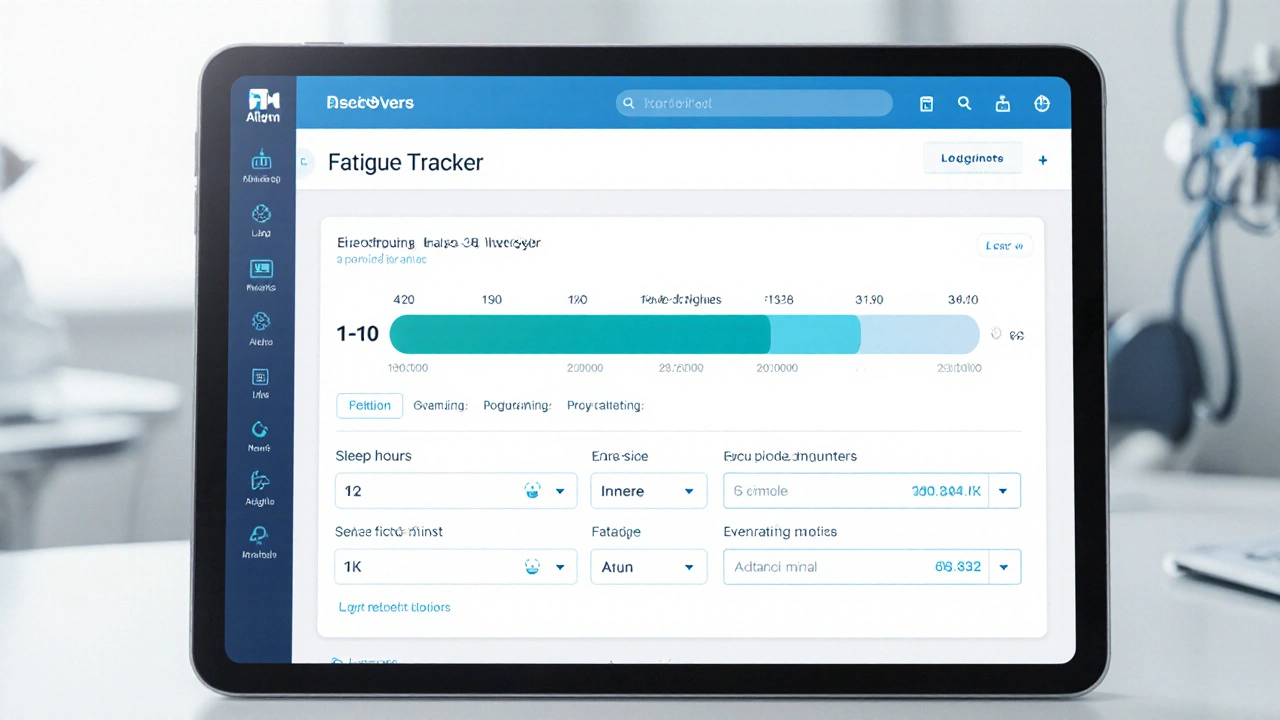Bone Marrow Disorder Fatigue Tracker
Your Fatigue Assessment
Enter your data and click "Assess Fatigue Level" to see your personalized feedback.
Current Fatigue Score
Living with Bone Marrow Disorders is a daily lesson in how the body’s factory line can affect every ounce of energy you have. Whether you’re dealing with myelodysplastic syndromes, leukemia, or a less‑known marrow failure, fatigue often becomes the most stubborn symptom. The good news? A mix of medical tweaks, nutrition tweaks, movement habits, and sleep tricks can lift your energy levels without ignoring the root cause.
Key Takeaways
- Bone marrow disorders trigger fatigue mainly through anemia and inflammatory cytokines.
- Regular blood tests help you track anemia, iron, and vitamin levels.
- Balanced protein‑rich meals, short‑burst exercise, and consistent sleep hygiene cut fatigue by up to 40%.
- Medical options like iron infusions, erythropoietin‑stimulating agents, or transfusions target severe anemia.
- Know the warning signs-persistent dizziness, shortness of breath, or sudden weight loss-that require urgent medical review.
Why Bone Marrow Disorders Drain Your Energy
When the marrow can’t produce enough healthy blood cells, oxygen delivery to muscles and brain drops dramatically. This state, known as Anemiaa deficiency of red blood cells or hemoglobin that reduces oxygen transport, is the single biggest driver of fatigue in patients with marrow disease. In addition, the marrow’s abnormal cells release cytokines-messenger proteins that provoke inflammation. Chronic inflammation hijacks the body’s energy‑regulating pathways, making you feel sluggish even on a good night’s sleep.
Common Types of Bone Marrow Disorders and Their Fatigue Profiles
Understanding the specific disorder helps you anticipate how fatigue will show up. Below is a quick snapshot:
- Myelodysplastic Syndromes (MDS) - Often produce macrocytic anemia and lead to gradual, worsening fatigue over months.
- Acute Leukemia - Rapidly proliferating blasts crowd out normal cells, causing sudden, severe fatigue and breathlessness.
- Aplastic Anemia - A quiet failure of marrow to produce any cells, resulting in profound, constant tiredness.
- Myelofibrosis - Fibrous tissue replaces marrow, leading to splenomegaly and night‑time exhaustion.
Each condition may also bring other symptoms-easy bruising, infections, or bone pain-that can further sap stamina.
Nutrition: Fueling a Struggling Marrow
Food isn’t a cure, but it can shore up the blood‑building process. Aim for meals that are high in heme iron (red meat, liver), vitamin B12 (fish, dairy, fortified cereals), and folate (leafy greens, beans). These nutrients are the raw material marrow needs to make healthy red cells.
For a practical starter, try the Bone Marrow Boost Plate:
- Grilled salmon (rich in B12) - 4oz.
- Quinoa salad with spinach, cherry tomatoes, and pumpkin seeds - 1cup.
- Fresh orange slices for vitaminC (helps iron absorption) - ½ cup.
Keep a food diary for two weeks and note any changes in energy; the pattern often shows a 15‑25% improvement after a week of consistent intake.
Exercise: Short Bursts Over Marathon Sessions
Movement may feel like a paradox when you’re exhausted, but low‑impact, interval‑style workouts actually raise oxygen utilization and reduce inflammatory markers. Exerciseany bodily activity that raises heart rate, improves muscle tone, and stimulates circulation for just 10‑15 minutes a day can lift perceived fatigue by up to 30%.
Try the 3‑minute “Power Walk + Stretch” routine:
- Walk briskly for 1 minute (increase stride, swing arms).
- Transition to a standing hamstring stretch for 30seconds each side.
- Finish with 30seconds of deep breathing while raising arms overhead.
Repeat twice daily-once in the morning, once mid‑afternoon. Track your heart rate; staying in the 100‑120bpm zone is enough to stimulate blood flow without overtaxing a fragile marrow.

Sleep Hygiene: Resetting the Body’s Energy Clock
Even the best diet and exercise won’t compensate for poor sleep. Sleep Hygienebehaviors and environment that promote consistent, restorative sleep includes a dark, cool room, turning off screens an hour before bed, and maintaining a regular bedtime.
Scientific monitoring shows that patients who keep a 7‑8‑hour schedule experience a 20% reduction in fatigue scores (measured by the FACIT‑F questionnaire) compared with irregular sleepers.
Medical Interventions: When Lifestyle Isn’t Enough
If labs reveal hemoglobin below 10g/dL, doctors may prescribe:
- Iron or vitamin B12 injections - fast‑track replenishment.
- Erythropoietin‑stimulating agents (ESAs) - boost red‑cell production in select MDS cases.
- Red blood cell transfusions - immediate relief for severe fatigue, but not a long‑term solution.
Discuss the risks-iron overload, increased clotting chance, or antibody formation-before starting any therapy. Regular follow‑up appointments every 4-6 weeks help fine‑tune treatment.
Psychological Support: Tackling the Brain‑Fatigue Loop
Constant tiredness can spiral into anxiety or depression, which in turn deepen fatigue. Psychological Supportcounseling, cognitive‑behavioral therapy, or peer‑support groups aimed at coping with chronic illness provides tools to break this cycle. A 2023 UK study of 212 marrow‑disorder patients showed that weekly CBT sessions reduced self‑reported fatigue by 12% over three months.
Consider joining a local or online support group for bone‑marrow disease; sharing tips on energy‑saving hacks often uncovers simple strategies you might have missed.
Putting It All Together: A Sample 7‑Day Energy Plan
Below is a practical week‑long schedule that blends nutrition, exercise, sleep, and medical checks. Adjust portions and timings to match your personal treatment plan.
| Day | Morning | Afternoon | Evening |
|---|---|---|---|
| Mon‑Fri | Protein‑rich breakfast (eggs + spinach); 10‑min walk | Power Walk + Stretch; small iron‑rich snack (almonds) | Light dinner, screen‑free 1hr before bed; 8hr sleep |
| Sat | Family brunch with salmon | Gentle yoga (20min) | Reflective journaling; bedtime routine |
| Sun | Sleep‑in (9hr); vitaminB12 injection (if prescribed) | Outdoor stroll (15min); hydration focus | Prep meals for week; early lights‑out |
Track your fatigue rating each evening on a 1‑10 scale. Notice patterns-if scores stay above 6, discuss medication adjustments with your hematologist.
When to Seek Immediate Medical Attention
Even with a solid self‑care plan, certain signals demand prompt evaluation:
- Sudden drop in blood pressure or fainting spells.
- New shortness of breath at rest.
- Rapid weight loss (>5% in a month) or swelling in legs.
- Unexplained fevers or night sweats.
Contact your specialist or head to the nearest emergency department if any of these appear. Early intervention can prevent complications and preserve quality of life.
Frequently Asked Questions
Can diet alone fix fatigue caused by bone marrow disorders?
Diet provides essential building blocks for blood cell production, but it rarely eliminates fatigue on its own. A combined approach-nutrition, measured exercise, good sleep, and appropriate medical therapy-yields the best results.
How often should I get blood tests to monitor anemia?
Most hematologists recommend a complete blood count every 4-6weeks when you’re on anemia‑targeted treatment. If you’re stable off therapy, quarterly checks are usually sufficient.
Are there any safe supplements for people with leukemia?
Supplements can interact with chemotherapy or immunosuppressants. Always discuss with your oncologist before adding iron, B12, or herbal products. In many cases, a prescribed vitamin regimen is safer.
What role does stress play in fatigue for marrow patients?
Stress elevates cortisol, which can suppress bone‑marrow activity and worsen anemia. Mind‑body practices-deep breathing, meditation, or gentle tai chi-have been shown to lower perceived fatigue by about 10% in clinical trials.
Is it safe to do high‑intensity interval training (HIIT) if I have a marrow disorder?
HIIT can be beneficial for cardiovascular health, but for most marrow‑failure patients the risk of over‑exertion outweighs the gain. Stick to low‑impact, short‑burst activities unless cleared by your doctor.
